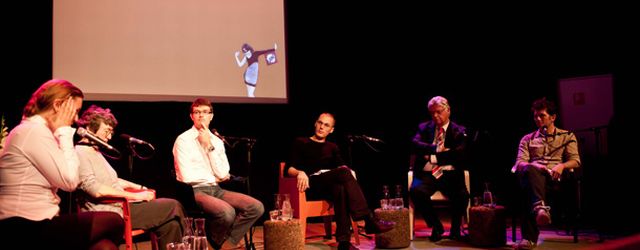![]() This year's debate season in Rotterdam opened in the renovated hall of The Union. The just-completed space has a pleasant and intimate feel. All the more remarkable the statement by discussion leader Natasja van den Berg that questions from the floor are not allowed 'cause those aren't about anything anyway'. That doesn't exactly sound like a warm welcome to a debate centre. However, the podium discussion under her tight leadership did deliver surprising added value. The extremely diverse speakers converged on a tantalising conclusion: the contemporary artist as participatory sociologist. But for now, the debate itself ruled out audience participation.
This year's debate season in Rotterdam opened in the renovated hall of The Union. The just-completed space has a pleasant and intimate feel. All the more remarkable the statement by discussion leader Natasja van den Berg that questions from the floor are not allowed 'cause those aren't about anything anyway'. That doesn't exactly sound like a warm welcome to a debate centre. However, the podium discussion under her tight leadership did deliver surprising added value. The extremely diverse speakers converged on a tantalising conclusion: the contemporary artist as participatory sociologist. But for now, the debate itself ruled out audience participation.
Completely out of the blue, van den Berg's ban did not come out of the blue. Traditionally, the Union debate season always starts with the Keuzedebat, which takes place on the stage of the Great Hall of the Rotterdam Schouwburg. Because of the physical separation between stage and audience, this is more of a 'talk show' where questions are tricky. But in the Union's intimate setting, the ban comes across as somewhat arrogant.
The debate itself, by the way, made a fresh impression. Besides Van den Berg (1975), there was a young guard comprising artists Jorge Leon and Jonas Staal and sociologist Willem Schinkel. For balance, there were the more experienced dramatist Marianne Van Kerkhoven and politician Ruud Vreeman.
Van Kerkhove, in particular, proves to be an extraordinary mix of whimsy and life wisdom. From her hand is the impressive installation series 'K, a Society'. This series, she says, shows people as they would be seen in an "end-image of the world".
The young filmmaker Jorge Leon is an adventurer. He collaborates with artists on the border of visual art, dance and theatre. He created the triptych 'To Serve'. He finds Lucidity or clarity of mind the most important aspect of art. Form no longer matters.
Jonas Staal (1981), the Rotterdam "agitator", promotes "a renewed pursuit of art for all in which young artists and progressive politics must again formulate a communal project".
Ruud Vreeman (1947) concludes that politics should learn from art's 'possibilities of identification and wonder'. This would allow populism and renewal politics to be thought together.
It is ultimately Willem Schinkel (1976) who sets the stage for the lucid conclusion of artist as participatory sociologist that the speakers ultimately feel at home with. Key question in contemporary art, according to him, is the question of 'the artist's relationship with his social environment. With this, global inequality, exploitation and oppression have become art themes'. Thus, the artist becomes a participatory researcher, but at the same time must be well aware that his result is recognisable as art, 'other he loses the ability to sell his result'.
Too bad the real listeners in the room were not allowed to ask anything about the paradigm shift in art pointed out by Van Kerkhove, or Staal's misunderstanding of Vreeman's conciliatory position. Or about Schinkel's account of reality as a collection of isolated spheres that itself claims absolute truth with no transcendent truth that can exist. So now the speakers walked off stage a little perplexed, unsure of what the audience actually thought.
'The International Choice Debate' by De Unie in Debat and the Rotterdam Schouwburg. Attended: Thursday 23 September at De Unie.
Photo: Rene Castelijn


Comments are closed.